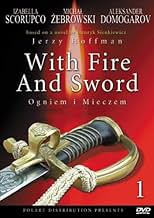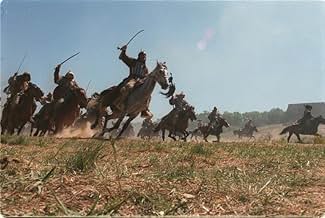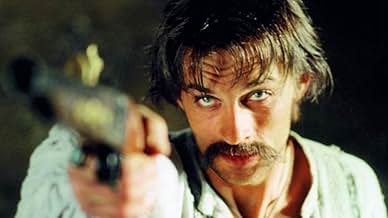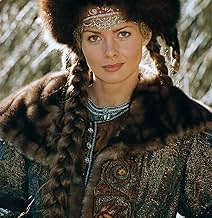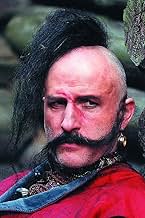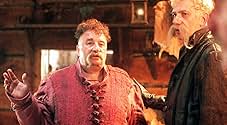Ogniem i mieczem
- 1999
- 2 h 55 min
AVALIAÇÃO DA IMDb
7,0/10
5,7 mil
SUA AVALIAÇÃO
Adicionar um enredo no seu idiomaAn epic story about the Ukrainian uprising against the Polish-Lithuanian Commonwealth magnates in the 17th Century.An epic story about the Ukrainian uprising against the Polish-Lithuanian Commonwealth magnates in the 17th Century.An epic story about the Ukrainian uprising against the Polish-Lithuanian Commonwealth magnates in the 17th Century.
- Direção
- Roteiristas
- Artistas
- Prêmios
- 5 vitórias e 9 indicações no total
Jacek Rozenek
- Jurko Bohun
- (narração)
Bogdan Stupka
- Bohdan Chmielnicki
- (as Bohdan S. Stupka)
Ruslana Pisanka
- Horpyna
- (as Ruslana Pysanka)
Avaliações em destaque
First of all, I am not delighted with Ogniem i Mieczem. But I think, it is a decent piece of adventure movie, which by the way, can also teach a bit about Poland's and Ukraine's history. There is one great thing, that Hoffman did - he modernized original Sienkiewicz's book, which was written in 1884 in very different circumstances. At that time, Poland was not existent country for almost 100 years, and the goal of Sienkiewicz's Trilogy was to raise Polish morale. That's why the Cossacks in the book are just enemies, evil and cruel, and their cause is not just, while the Poles (and loyal Ukrainians, like Prince Jeremi Wisniowiecki) are good, less cruel, and their cruelty is justified. Hoffman made a movie for modern times instead, when Poland and Ukraine are independent neighbors and they have to cooperate and built friendship among citizens (I must add here, that last local slaughters between citizens of two nations took part during World War II). In a movie, we see also Ukrainian point of view. Of course, the movie still remains Polish-centric, but it also shows Cossacks as people, who had they cause as well - what was guaranteed by engaging the Ukrainian actor (Bohdan Stupka) as Khmelnytsky.
Of the cast, Zbigniew Zamachowski as a fencing master Michal Wolodyjowski is disappointing, but I think he must have been under pressure of comparisons with highly praised Tadeusz Lomnicki, who played this character in earlier other two parts. And yes, Scorupco was a bad choice - after several days of marching through villages and bushes, she still looks like a cosmetic advertisement ("Despite all these things, my make-up still remains intact"). On the other hand, Daniel Olbrychski, playing a minor part of Tukhay-Bey, reached the mastery in my opinion.
Of the cast, Zbigniew Zamachowski as a fencing master Michal Wolodyjowski is disappointing, but I think he must have been under pressure of comparisons with highly praised Tadeusz Lomnicki, who played this character in earlier other two parts. And yes, Scorupco was a bad choice - after several days of marching through villages and bushes, she still looks like a cosmetic advertisement ("Despite all these things, my make-up still remains intact"). On the other hand, Daniel Olbrychski, playing a minor part of Tukhay-Bey, reached the mastery in my opinion.
Mostly for Polish viewers, some basic knowledge of 17th century Poland may be helpful if you want to understand the movie. It's about the rebellion of Ukrainian Cossacks against their lords - Polish nobility (it was before tsars conquered Ukraine). Polish prince Jeremi Wisniowiecki fights them with extreme atrocity but when they ally with Tatars, is forced to withdraw to the fortress of Zbaraz. These events form a background for the love between one of Polish commanders and girl he meets while carrying out some emissary mission for the prince. The movie is based on the novel "With Fire and Sword" (orig. "Ogniem i mieczem") by Henryk Sienkiewicz (Nobel award for "Quo Vadis"). This book is the first part of a trilogy, other parts have also been filmed. I think it's important to read the novel and see all mentioned movies - "The Deluge" (orig. "Potop") and "Pan Michael" (orig. "Pan Wolodyjowski").
10denis888
I first saw Ogniem I Mieczem in Poland in 2000, where I was working and learning Polish. That is true that one has to know Polish well enough to perceive this magnificent epic drama, but at the same time this film was broad-casted in Russia, my homeland, dubbed into Russian, and many people watched it and loved it very much. I agree that you have probably to be Polish to understand this film, but this is not a must. All you need is some basic knowledge of the Polish Russian Ukrainian history of the 17th century. Terrible wars were waging all that time between Poland, Russia and Ukraine. Since there are three nations close to one another, that conflict made it all even worse, when true brothers were killing each other. Jerzy Hoffman is a real master of the historical movies; he had already achieved great popularity with Potop and Pan Wolodyjowski, two other films based as Ogniem I Mieczem on the novels of the Nobel Prize Winner Henryk Sienkiewicz. Thus, in OiM he managed to depict very tragic and romantic events on a really grand scale. The battle scenes are simply second to none, and you feel all that pain and suffering of people fighting there. The scene when the Ukrainian army under Bohdan Chmelnicki (played by the famous Ukrainian actor Bohdan Stupka) attacks continually the castle called Zbararz is impeccable. The casting job was also done marvelously. You cannot imagine anybody else but the Russian film star Alexander Domogarov in the part of Jurek Bohun, a riotous Ukrainian colonel. He plays with such unrestrained passion and vigor that, even being certainly a "baddie", he arouses a great sympathy and admiration. Isabella Scorupco is an excellent choice for the main female part (the love story in the movie is very touching and likewise very tragic), while Zbiegniew Zamachowski is great playing a small but brave feigner and loyal soldier. The famous Polish actor Marek Kondrat is there in a very small but highly emotional role of the king Jan Kazimierz, weak and powerless ruler whose heart aches for his Motherland. Also, pay attention to a merciless but brave Count Jeremi Wisniewiecki, who tried all his best to put an end to that horrible war. And it's impossible to forget another Ukrainian actress, Ruslana Pysanka in the role of the witch Horpyna her performance is blood-chilling and at the same time very entertaining. In fact, all, even smaller parts of this crew (Pan Zagloba, Senator Kissiel, Tuhaj-Bej, Tatarczuk, Longin Podbipieta) are in their places and add much to the film. The nature scenes are another plus of this film; you cannot but admire the wide open plains, slow waters, deep forests and snowy mountains all shown with real gusto. Music adds another dimension, this mix of Russian, Polish and Ukrainian folk tunes serves its duty it trills you, holds you all the time and stays in your ears long after the movie ended. I was thrilled after having watched this epic for the 1st time, and this feeling remains in me even after numerous re-runs. What I really love in this film is the main message that Mr. Hoffman made clear a civil war is terrible, no aim and no word may justify this entire bloody massacre. The final scene when we learn that all this heroic struggle of the Poles was in fact in vain is deeply touching and I can understand all those who were weeping while watching. No, you don't have to be a Pole yourself to catch the main idea of the movie. You simply have to be a person with a big heart and sincere feelings to feel pain, suffering, strife and grief of the oppressed. This movie is a splendid work of art of the big master, having lost none of its emotional message with the run of time. Highly recommended
Granted that I saw this movie in a Sydney cinema packed with Poles (including my Polish wife sitting next to me), the number of weeping expats at the final credits suggested that I needed at least some Polish blood to fully appreciate the experience. Objectively, O i M is a handsomely mounted costume piece with good attention to military details and minor roles (Pan Zagloba in particular), but is let down by lack of polish (no pun intended) and a number of unintentionally hilarious touches such as Scorupco's mile-long plaits and Daniel Olbrychski chewing the scenery at every opportunity. Even with subtitles, the historical narrative remains biased and confusing, and the whole enterprise is infused with an almost quaint Polish naivete and prudishness (except for the depiction of graphic violence, of course). Is it any worse however, than 'Glory' or 'Gettysburg' however? Probably not. 6 out of 10
As a movie based on a book that is a staple of Polish reading, it is bound to attract its adherents and detractors. But overall it has enough merit to it to warrant at least a single viewing.
The story is set in the 17th century, during a period of strife on the eastern fringes of Polish territory, in today's Ukraine. The main plot centers around a rebellion of Cossacks against the oppression of Polish landowners, in the greater setting of a conflict between Poland, Muscovy and the Tartars.The book was written from a Polish standpoint, so there is some obvious favoritism shown, but the main characters are not one dimensional. The motivations of the characters are clearly explained, and the good guy is not always good, and the bad guy is not always bad. The political intricacies may be a bit confusing, but at its heart this movie is a love triangle, so as long as you focus on that, you can follow along.
The main reason to watch this movie is visual. If you are one of those people who likes to have a movie transport them to another time and place, this movie is for you. The costumes, props and scenery are simply beautiful. All the characters speak in the language they are supposed to speak, so you have conversations in Polish, Ukranian and even Tartar. The performances by the main characters are wonderful, ranging from comedy to romance to drama to action.
The movie has a bit of something for everyone. If you like action, the battle sequences are fantastic, very massive in scale. If you like romance, the lead characters are not too hard on the eyes, and their passionate feelings come across the screen quite strongly. There is a very strong comedy element as well, but you might have to understand Polish to appreciate it fully.
The special effects in this movie leave a bit to be desired. It certainly is a bloody, and at times gory film, but really no worse than a lot of recent US offerings.
If I was to use a US movie as a thematic comparison, Last of the Mohicans might be a good choice, with the hero looking for his love in a wild and savage environment.
Overall I would recommend this movie to fans of historical films. The plot is fairly straightforward, so you can focus on watching the visuals instead.
The story is set in the 17th century, during a period of strife on the eastern fringes of Polish territory, in today's Ukraine. The main plot centers around a rebellion of Cossacks against the oppression of Polish landowners, in the greater setting of a conflict between Poland, Muscovy and the Tartars.The book was written from a Polish standpoint, so there is some obvious favoritism shown, but the main characters are not one dimensional. The motivations of the characters are clearly explained, and the good guy is not always good, and the bad guy is not always bad. The political intricacies may be a bit confusing, but at its heart this movie is a love triangle, so as long as you focus on that, you can follow along.
The main reason to watch this movie is visual. If you are one of those people who likes to have a movie transport them to another time and place, this movie is for you. The costumes, props and scenery are simply beautiful. All the characters speak in the language they are supposed to speak, so you have conversations in Polish, Ukranian and even Tartar. The performances by the main characters are wonderful, ranging from comedy to romance to drama to action.
The movie has a bit of something for everyone. If you like action, the battle sequences are fantastic, very massive in scale. If you like romance, the lead characters are not too hard on the eyes, and their passionate feelings come across the screen quite strongly. There is a very strong comedy element as well, but you might have to understand Polish to appreciate it fully.
The special effects in this movie leave a bit to be desired. It certainly is a bloody, and at times gory film, but really no worse than a lot of recent US offerings.
If I was to use a US movie as a thematic comparison, Last of the Mohicans might be a good choice, with the hero looking for his love in a wild and savage environment.
Overall I would recommend this movie to fans of historical films. The plot is fairly straightforward, so you can focus on watching the visuals instead.
Você sabia?
- CuriosidadesThe trilogy of books on which this movie and its predecessors are based was actually filmed in reverse order. The first movie to be made, 'Pan Wolodyjowski (1969)', is based on the final book of the trilogy, the second movie, 'Potop (1974)', was the second book and 'Ogniem i mieczem', the final movie to be made, is based on the first book.
- Erros de gravaçãoThe pikes used by the infantry should be much longer, as they are of little use being so short. Pikes are pole arms, typically of 10 to 25 feet in length.
- Versões alternativasOn April 14 2001 the first channel of Polish public television aired the first part of the television version of the movie. The television version is almost 30 minutes longer than the version previously shown in the cinemas and contains of four episodes. It includes some scenes that were deleted from the theatrical edition, e.g. scenes with Krystyna Feldman and Agnieszka Krukówna playing Ukrainian women or Magdalena Warzecha playing Gryzelda Wisniowiecka.
- Trilhas sonorasDumka na dwa serca
Lyrics by Jacek Cygan
Music by Krzesimir Debski
Performed by Edyta Górniak & Mietek Szczesniak
Principais escolhas
Faça login para avaliar e ver a lista de recomendações personalizadas
- How long is With Fire and Sword?Fornecido pela Alexa
Detalhes
- Data de lançamento
- País de origem
- Central de atendimento oficial
- Idiomas
- Também conhecido como
- With Fire and Sword
- Locações de filme
- Empresas de produção
- Consulte mais créditos da empresa na IMDbPro
Bilheteria
- Orçamento
- PLN 24.000.000 (estimativa)
- Tempo de duração2 horas 55 minutos
- Cor
- Mixagem de som
- Proporção
- 2.35 : 1
Contribua para esta página
Sugerir uma alteração ou adicionar conteúdo ausente

Principal brecha
By what name was Ogniem i mieczem (1999) officially released in India in English?
Responda
